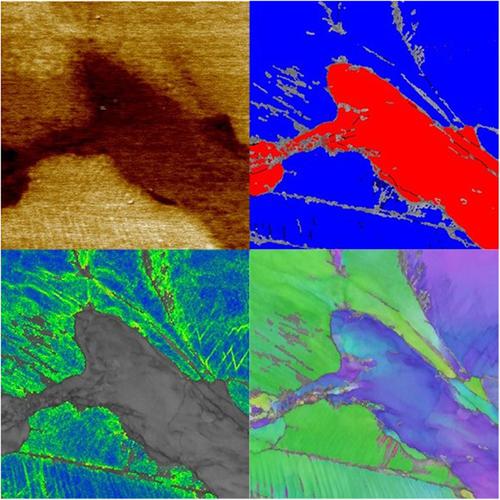当前位置:
X-MOL 学术
›
Mater. Corros.
›
论文详情
Our official English website, www.x-mol.net, welcomes your
feedback! (Note: you will need to create a separate account there.)
Effect of cold rolling on microstructure, corrosion and electrochemical response of the lean duplex stainless steel LDX 2101® by a correlative EBSD–SKPFM investigation
Materials and Corrosion ( IF 1.6 ) Pub Date : 2020-03-18 , DOI: 10.1002/maco.202011588 Nuria Fuertes 1 , Rachel Pettersson 2
Materials and Corrosion ( IF 1.6 ) Pub Date : 2020-03-18 , DOI: 10.1002/maco.202011588 Nuria Fuertes 1 , Rachel Pettersson 2
Affiliation

|
This study elucidates the effect of cold rolling on the microstructure, corrosion and electrochemical response of the lean duplex stainless steel LDX 2101®. With thickness reductions of 0%, 20% and 40%, three different specimens are investigated in terms of microstructure (electron backscattered diffraction [EBSD] and energy‐dispersive X‐ray spectroscopy [EDS]), corrosion properties (ASTM G150, ASTM G61 and field testing), passive film properties (X‐ray photoelectron spectroscopy) and electrochemical response (scanning Kelvin probe force microscopy [SKPFM]). It is shown that deformation of LDX 2101 leads to changes in the microstructure such as mechanical twinning and martensite formation. The combination of EBSD, EDS and SKPFM maps shows that the work function is clearly dependent on composition, deformation and local misorientation, but not on the crystallographic orientation of the grains in the microstructure. Zones with low work function are seen to have the highest pitting susceptibility, which includes deformed ferritic, martensitic phase and areas with a high concentration of dislocations such as grain boundaries and mechanical twins. The overall conclusion is that cold deformation up to a 40% thickness reduction has a significant influence on the microstructure, but a small impact on the corrosion resistance of LDX 2101.
中文翻译:

通过相关的EBSD–SKPFM研究,冷轧对贫双相不锈钢LDX2101®的组织,腐蚀和电化学响应的影响
这项研究阐明了冷轧对贫双相不锈钢LDX2101®的组织,腐蚀和电化学响应的影响。随着厚度的减少0%,20%和40%,研究了三种不同的试样的微观结构(电子背散射衍射[EBSD]和能量色散X射线光谱法[EDS]),腐蚀性能(ASTM G150,ASTM G61和现场测试),被动膜性能(X射线光电子能谱)和电化学响应(扫描开尔文探针力显微镜[SKPFM])。结果表明,LDX 2101的变形会导致微观结构发生变化,例如机械孪晶和马氏体形成。EBSD,EDS和SKPFM图的组合表明,功函显然取决于成分,变形和局部取向错误,而不是微观结构中晶粒的晶体学取向。功函数低的区域被认为具有最高的点蚀敏感性,其中包括变形的铁素体相,马氏体相以及位错浓度高的区域,例如晶界和机械孪晶。总的结论是,冷变形直至厚度减少40%时,对显微组织都有重要影响,而对LDX 2101的耐腐蚀性影响很小。
更新日期:2020-03-18
中文翻译:

通过相关的EBSD–SKPFM研究,冷轧对贫双相不锈钢LDX2101®的组织,腐蚀和电化学响应的影响
这项研究阐明了冷轧对贫双相不锈钢LDX2101®的组织,腐蚀和电化学响应的影响。随着厚度的减少0%,20%和40%,研究了三种不同的试样的微观结构(电子背散射衍射[EBSD]和能量色散X射线光谱法[EDS]),腐蚀性能(ASTM G150,ASTM G61和现场测试),被动膜性能(X射线光电子能谱)和电化学响应(扫描开尔文探针力显微镜[SKPFM])。结果表明,LDX 2101的变形会导致微观结构发生变化,例如机械孪晶和马氏体形成。EBSD,EDS和SKPFM图的组合表明,功函显然取决于成分,变形和局部取向错误,而不是微观结构中晶粒的晶体学取向。功函数低的区域被认为具有最高的点蚀敏感性,其中包括变形的铁素体相,马氏体相以及位错浓度高的区域,例如晶界和机械孪晶。总的结论是,冷变形直至厚度减少40%时,对显微组织都有重要影响,而对LDX 2101的耐腐蚀性影响很小。










































 京公网安备 11010802027423号
京公网安备 11010802027423号